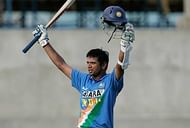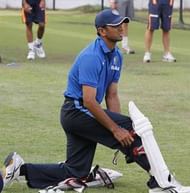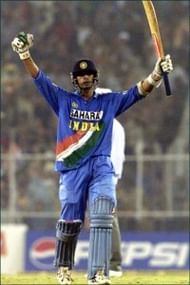
Classy, adaptable and ever dependable – For his grand services to Indian cricket in ODIs, Dravid automatically selects himself as one of India’s finest ever in his country’s favorite format.
Play on the flat tracks with true bounce. Disregard him. Play on swinging conditions. Put him on high alert. Play on bouncy wickets. Get him to do his job. Somehow, the way Indian cricket has dealt with a certain legend, Rahul Dravid in the shorter format of the game, has left too many questions unanswered on the quality of India’s batsmen against testing conditions. At the same time, it has been soundly proven that Dravid is a timeless champion. A savior in the true essence of the word, Dravid’s presence has been the single most influencing factor in the way India’s ODI fortunes have changed holistically since the dawn of new millennium.
“Bahut sochta hain” apparently was the reason why Dravid found himself out of the Indian team for the first time way back in 1997. Indian cricket celebrates him today as a living legend, but it is surprising to note that Dravid at one point of time early in his career was short of confidence and had to consult a sports psychologist. Add to all that, the levels of abuse the Mumbai crowd got into, when Dravid was eventually out for 1 off 21 balls against Bangladesh in 1998!
Careers for young cricketers could make or break at such moments. He was called, Rahul “The Well Left” Dravid for his slow-paced batting. Ashish Shukla on rediff.com wrote, “Fate presented him with one more chance, and Dravid abdicated. Two dismissals that owed to good cricket by the opposition, and two others that owed more to his own inner tensions, and there is an air now of finality about Dravid’s one-day career.”
To be called a “test” batsman among India’s youth (a criticism Cheteshwar Pujara is going through currently) points to defensive style of batting with text book strokes. It is something now they would never want to be associated with. Dravid had to fight hard to shred off that tag.
Mr. Adaptable
Rahul Dravid Version 2.0, released in New Zealand (1998-99), was the one which had covered almost all his weaknesses, previously noticed. There was urgency in his stroke play. While he was earlier found to sweetly hit the ball straight to the fielder, here was the batsman who started to pierce the gaps freely and rotate the strike, much better than others, at times.
This prompted Sachin Tendulkar to speak up for his mate,
“Let us accept that there was a time when he struggled to rotate the strike in one-day internationals. His strike-rate was not upto the mark. Every player goes through such a phase, but the better ones come back hard and Rahul did just that.”
One of his more memorable individual performances since that was the hard working century at Chepauk (he scored that one at a strike rate above 90!) against Pakistan. Dravid’s big hundred in World Cup against Sri Lanka showed a renewed image of someone who, when on song, can sketch strokes freely and even overpower the bowling attack with finesse. Devendra Prabhudesai who authored Dravid’s biography, “The Nice Guy Who Finished First” went on to compare the strokes in that innings with strokes of cricket’s finest batsmen –
“Rahul’s on-drive were as elegant as Chappell’s, his straight-drives as graceful as Gavaskar’s, his cuts as flawless as Crowe’s, his cover-drives as stunning as those played by Richards and the lofted drives he essayed later in the innings as spectacular as Botham’s.”
While his test career was in full motion, Dravid’s adaptability and his skills in the shorter-format reached another level in the same game when he replaced Nayan Mongia as the ‘keeper.
Being Ganguly’s deputy, Dravid did complete justice to his role with his performances throughout. Throughout those years in the early 2000s, when India’s performances across the world were noticed, Dravid’s double role as wicket keeper and the batsman at No.3 helped Ganguly pull in an extra batsman to beef up the batting order.
It is hard to even find a person who has sacrificed so much and done more than one could actually do for Indian team than Rahul Dravid. Probably, Navjot Sidhu put it in the best possible way – “Rahul is a player who will walk on broken glass if his team tells him to.” With all due respect to Tendulkar and Ganguly, it is hard to imagine if they would go so much distance to do for the team, as much as Dravid did in his whole career.
Playing second fiddle… Unfortunately
Each time, Dravid scored an ODI hundred, someone else stole the show. While it was Anwar in the opposition ranks at Chennai, it was Ganguly at Taunton. However India’s coach during the tour Anshuman Gaekwad carried an interesting sentiment about his knock at Taunton -
“It was Rahul who initiated the onslaught. That was the day he proved beyond doubt that he was as capable of overpowering a bowling attack in a one-day international as anybody else.”
When Dravid scored his only 150+ score in Hyderabad against Kiwis, Tendulkar stole the show with his record breaking 186. When India were in deep trouble (87-5) in the opening game of ICC Champions Trophy in 2002, Kaif’s century took away the shine off Dravid’s crucial 71!
A work ethic like none
Dravid’s always been one of India’s cricketers who believed in “first-to-arrive-last-to-leave” attitude towards practice. His efforts leading to the World Cup in 2003 were ones to remember and be inspired from. He practiced against a bowling machine at indoor nets in Bangalore with a bat just two-and-a-half inches wide. The machine was programmed to deliver balls landing short of a length outside off-stump. He was rising and patting deliveries down in front of square on the off-side. According to one of India’s leading commentators, Charu Sharma, “The idea was to play them in an unmanned region of the field and steal a single. The thinking obviously was, “If I can middle the ball with this narrow bat, then I can middle anything.” He practiced this drop-shot for hours and hours.”

A savior in its true essence, Dravid’s presence has been the single most influencing factor in the way, India’s ODI fortunes have changed holistically since the dawn of new millennium.
The shot was very much in motion during that dramatic chase at Motera against West Indies (2002), where Dravid scored yet another crucial hundred. He was an exponent of that stroke to steal the single, during that memorable Natwest Tri Series (2002).
His fitness levels have been thoroughly amazing. Dravid has been a thorough professional competing with young boys after 15 long years of international cricket. India’s physiotherapist, Andrew Leipus had his own say on Dravid’s professionalism,
“In my initial days with the team, I would look to identify some enthusiastic guys and work hard on them, hoping that the improvements they would make would inspire the others who were not as enthusiastic about fitness or training. Rahul was one of the enthusiastic players I identified as a ‘leader’.
“The responsibility of wicket keeping meant that he had to do additional work on the lower back and hamstrings. But then, he was so fit in the first place that it was merely a case of conditioning himself to the demands on keeping. His fitness enabled him to adapt quickly.”
Crisis Man
Hindsight is such a wonderful thing! To see some of Dravid’s essays now makes me notice his real class in times of crisis. While today’s youngsters are still searching for the perfect balance between the right amount of aggression and defence, a look at Dravid’s finest days shows the class of the man he actually is.
Every time India played in New Zealand, England, Australia and South Africa, India wanted Dravid. And they were ready to pick him from obscurity too. He was a class apart! With no compromise in his fluent and text book strokes in an era of Dilscoops and Palti Hits, Dravid showed what was missing among youngsters’ ranks – the technical skill to play the rising ball and the mental skill to develop temperament.
While many called his inclusion in the team for the Champions Trophy in 2009 as a step backward, Team India had no options but to prefer the man during crisis. And the story never ended there.
The moment the tour was over, Dravid wasn’t in the selectors’ radar for another 2 years in the 50-over format. When he found his touch in the test series when every other batsman on tour struggled, they had no option but to retain him for the full tour, including the T20s. Who knows, the selectors might still put him on duty during the tour Down Under later this year!

He was that classic Carnatic musician who walked into the stage filled with celebrated band of rock stars performing to the audience! While people found him odd on the stage with other stars, the classy musician in him composed tunes that made the rock music crazy crowds sit up, take notice of him and appreciate his talent.
The crisis man handled not just swing, pace and bouncy tracks. He also had to take up the leadership from Ganguly at a time when Indian cricket was in jeopardy. It was, as many call, a dark period in Indian cricket. Chappell’s influence and his decision making in the team was publicly disapproved by his players. Despite all that, Dravid, the ODI captain led India to one of the more memorable team records of recent times in India’s shining cricket history – Most number of consecutive ODI wins while chasing (17). Dravid alone led India to victory in 15 of those games.
It is true he has had his set of failures, both as a batsman as well as captain in ODIs. Unlike many cricketers who’ve lost the battle of minds early in their career, Dravid showcased himself as an inspiration for many young cricketers to make it happen when the whole world turns against them.
Classy, rock solid and ever dependable – Rahul Dravid has done so much to Indian cricket in ODIs with the bat, behind the stumps, as a deputy and as a leader that he automatically gets selected as one of India’s finest ever one-day players. It would be hard to imagine for someone else to take up his favorite #3 position even in ODIs.
Ten thousand runs are a testimony to his longevity in that brand of cricket where people betted that he would choke down. Unlike the test arena, Rahul Dravid had to struggle to find an identity for himself in the one-dayers. He was that classic Carnatic musician who walked into the stage filled with celebrated band of rock stars performing to the audience! While people found him odd on the stage with other stars, the classy musician in him composed tunes that made the rock music crazy crowds sit up, take notice of him and appreciate his talent.
Rahul Dravid – Take a bow!
Follow IPL Auction 2025 Live Updates, News & Biddings at Sportskeeda. Get the fastest updates on Mega-Auction and cricket news
